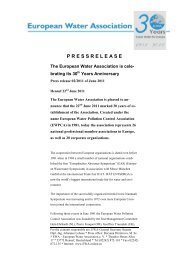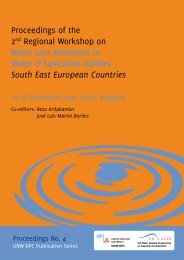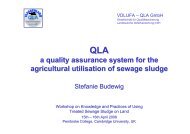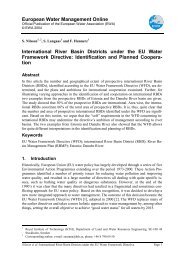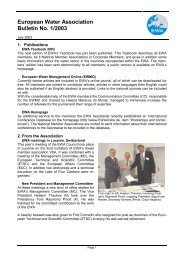Implementation of the Water Framework Directive and other ...
Implementation of the Water Framework Directive and other ...
Implementation of the Water Framework Directive and other ...
You also want an ePaper? Increase the reach of your titles
YUMPU automatically turns print PDFs into web optimized ePapers that Google loves.
Wastewater treatment <strong>and</strong> WFD 1 st December 2005<br />
implementation in CEE Danube countries Bratislava, Slovakia<br />
Pressures by organic oxygen depleting pollution � Saprobic risk<br />
Pressures by plant nutrients (nitrate <strong>and</strong> phosphate) � Trophic risk<br />
Pressures by specific pollutants � Chemical risk<br />
Pressures by hydromorphological alterations <strong>of</strong> surface waters � Structural risk.<br />
Table 4: Risk assessment <strong>of</strong> rivers – German Danubian part<br />
Risk category Not at risk Risk unclear At risk<br />
Saprobic risk 65 % 18 % 17 %<br />
Trophic risk 67 % 5 % 28 %<br />
Chemical risk 97 % 2 % 1 %<br />
Structural risk 29 % 37 % 34 %<br />
(Figures in % <strong>of</strong> river stretches)<br />
The assessment <strong>of</strong> rivers deliberately has been separated into <strong>the</strong> four risk categories to make<br />
clear different problems <strong>of</strong> water quality <strong>and</strong> <strong>the</strong>ir specific causes. Ano<strong>the</strong>r reason for a<br />
multiple assessment is a fundamental difference in <strong>the</strong> importance <strong>of</strong> <strong>the</strong>se categories for a<br />
good ecological status. For achieving a good status <strong>of</strong> a water body <strong>the</strong> biological <strong>and</strong><br />
chemical criteria are decisive whereas hydromorphological criteria are only supporting<br />
elements <strong>and</strong> have more importance for <strong>the</strong> allocation <strong>of</strong> possible measures.<br />
The assessment <strong>of</strong> lakes <strong>and</strong> groundwater is not presented in this contribution, but is available<br />
on www.wasserrahmenrichtlinie.bayern.de .<br />
The Conference <strong>of</strong> <strong>the</strong> Environment Ministers <strong>of</strong> <strong>the</strong> German Federal States in May 2005<br />
declared based on <strong>the</strong> reports <strong>of</strong> all 16 Federal States that <strong>the</strong> key issues in order to reach <strong>the</strong><br />
good status in 2015 are<br />
o Diffuse nutrient pollution (particularly agriculture)<br />
o Hydromorphological alterations (due to dense settlement <strong>and</strong> long civilization in<br />
Germany)<br />
o In very few cases punctual pollution by hazardous substances<br />
6 COMBINED APPROACH<br />
There are essentially two strategies applied for reaching <strong>the</strong> goals <strong>of</strong> pollution control.<br />
On <strong>the</strong> one h<strong>and</strong> we have <strong>the</strong> fixed emission st<strong>and</strong>ard approach <strong>and</strong> on <strong>the</strong> o<strong>the</strong>r h<strong>and</strong> <strong>the</strong><br />
environmental quality st<strong>and</strong>ard approach. The German national water protection policy was,<br />
from 1945 onwards, predominantly based on <strong>the</strong> fixed emission approach.<br />
The fixed emission approach is based on <strong>the</strong> assumption that anyone who discharges<br />
wastewater into a water body must at least purify this wastewater in compliance with <strong>the</strong> set<br />
st<strong>and</strong>ards, which must comply with <strong>the</strong> best available technology. The status <strong>of</strong> <strong>the</strong> water into<br />
which <strong>the</strong> wastewater is discharged is <strong>of</strong> no relevance in this context. The environmental<br />
quality st<strong>and</strong>ard approach, on <strong>the</strong> o<strong>the</strong>r h<strong>and</strong>, takes <strong>the</strong> actual or desired status <strong>of</strong> <strong>the</strong> receiving<br />
water as a basis. Requirements for <strong>the</strong> discharge may differ substantially depending on <strong>the</strong><br />
conditions in <strong>the</strong> receiving water.<br />
The environmental quality st<strong>and</strong>ard approach is sometimes criticised because <strong>of</strong> <strong>the</strong> lack <strong>of</strong><br />
knowledge in <strong>the</strong> interpretation <strong>of</strong> <strong>the</strong> receiving water status <strong>and</strong> <strong>the</strong> necessary huge<br />
monitoring work. On <strong>the</strong> o<strong>the</strong>r h<strong>and</strong>, o<strong>the</strong>rs say that particularly in <strong>the</strong> case <strong>of</strong> small water<br />
- 91 -



